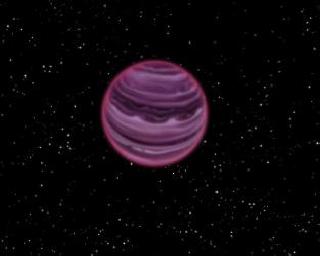
Artists impression of the solitary object PSO J318.5-22 discovered by a group of astronomers led by Michael Liu from the University of Hawaii, and including Niall Deacon from the Max Planck Institute for Astronomy. Photo: MPIA / V. Ch. Quetz.
WASHINGTON (PTI): A young exotic planet - six times more massive than Jupiter - has been discovered floating all alone without a sun about 80 light-years from Earth.
The planet, dubbed PSO J318.5-22, formed a mere 12 million years ago - a newborn in planet lifetimes.
It was identified by an international team of astronomers from its faint and unique heat signature by the Pan-STARRS 1 (PS1) wide-field survey telescope on Haleakala, Maui.
Follow-up observations using other telescopes in Hawaii show that it has properties similar to those of gas-giant planets found orbiting around young stars. And yet PSO J318.5-22 is all by itself, without a host star.
"We have never before seen an object free-floating in space that looks like this. It has all the characteristics of young planets found around other stars, but it is drifting out there all alone," said team leader Dr Michael Liu of the Institute for Astronomy at the University of Hawaii at Manoa.
"I had often wondered if such solitary objects exist, and now we know they do," said Liu.
Only a handful of planets have been directly imaged, all of which are around young stars - less than 200 million years old. PSO J318.5-22 is one of the lowest-mass free-floating objects known, perhaps the very lowest, researchers said.
But its most unique aspect is its similar mass, colour, and energy output to directly imaged planets.
"Planets found by direct imaging are incredibly hard to study, since they are right next to their much brighter host stars. PSO J318.5-22 is not orbiting a star so it will be much easier for us to study. It is going to provide a wonderful view into the inner workings of gas-giant planets like Jupiter shortly after their birth," said Dr Niall Deacon of the Max Planck Institute for Astronomy in Germany and a co-author of the study.
PSO J318.5-22 was discovered during a search for the failed stars known as brown dwarfs. Due to their relatively cool temperatures, brown dwarfs are very faint and have very red colours.
PSO J318.5-22 stood out as an oddball, redder than even the reddest known brown dwarfs.
The planet is extremely cold and faint, about 100 billion times fainter in optical light than the planet Venus. Most of its energy is emitted at infrared wavelengths.
The team followed up the PS1 discovery with multiple telescopes on the summit of Mauna Kea on the island of Hawaii.
Infrared spectra taken with the NASA Infrared Telescope Facility and the Gemini North Telescope showed that PSO J318.5-22 was not a brown dwarf, based on signatures in its infrared light that are best explained by it being young and low-mass.
Based on its distance, about 80 light-years, and its motion through space, the team concluded that PSO J318.5-22 belongs to a collection of young stars called the Beta Pictoris moving group that formed about 12 million years ago.
The study appears in the Astrophysical Journal Letters.
 Previous Article
Previous Article Next Article
Next Article













The Indian Air Force, in its flight trials evaluation report submitted before the Defence Ministry l..
view articleAn insight into the Medium Multi-Role Combat Aircraft competition...
view articleSky enthusiasts can now spot the International Space Station (ISS) commanded by Indian-American astr..
view article